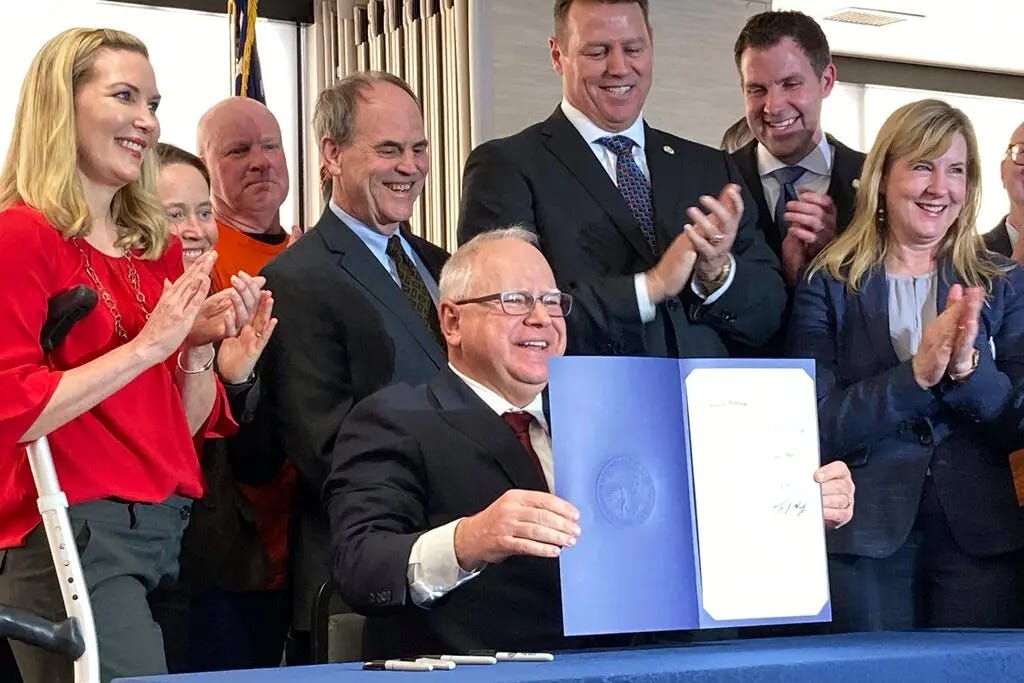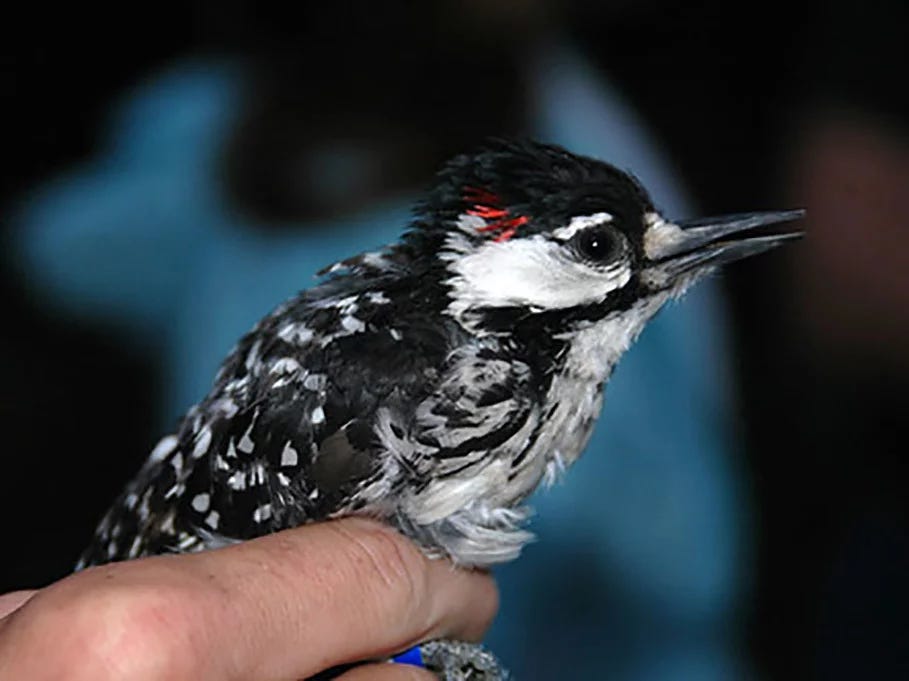Refugia Newsletter #74
Walz and down-ticket candidates on climate, battery recycling, military wildlife refugia, and a glorious sky
Refugia News
Hello, friends. As this strange summer comes to a close, I find myself weary for many reasons, not least the death of my dear father-in-law last week at age 87. Maybe you’re weary, too, for your own reasons, so I’ll try to focus this edition of the newsletter on things that give energy and joy.
Next week, I’ll gain a little energy from stopping in to visit to two different book groups who have been reading Refugia Faith, one here in Michigan, another in the Washington DC area (that one will be an online visit). I’m so grateful that people continue to find the book meaningful. Meeting a whole network of wonderful faith/climate people all over the country has been such a gift!
Also giving me energy in the past couple weeks are the many, many organizing calls to support the Kamala-Walz campaign. I listened in on the “Elders for Kamala” call and the “Christians for Kamala” call, both enormously inspiring. You can watch the recordings yourself at the links. Many of the older speakers on these calls testified that they had never in their lives seen such energy and organizing savvy around a US presidential campaign. What a wild moment in our history!
Were you part of other faith-related calls whose recordings I could link to in this newsletter? Let me know by leaving a comment.
Finally, here’s an interfaith opportunity for clergy and faith leaders. “Preaching an Election Sermon: An Interfaith Workshop,” sponsored by Third Act Faith, aims to help clergy and other faith leaders find winsome ways to talk about how critical this election season is both for climate and democracy. This two-hour Zoom event will take place on Tuesday, August 27, at 4:00 pm PT/7:00 pm ET, and will be led by the Rev. Dr. Jim Antal, Rabbi Stephanie Kolin, and Imam Jamal Rahman. Learn more about the event here. Register here.
Did you know that bees take little naps in flowers? Yes! I caught this bumble bee snoozing comfortably in my zinnias the other day. My pollinator identification book lists 18 types of native bees in my area. I think I’ve seen most of these types in my pollinator gardens. Never met so many bees before!
This Week in Climate News
Let’s stay with US politics for a bit here because, since last time, VP Harris announced Minnesota Governor Tim Walz as her running mate. How is Walz on climate issues? Well, I’ve seen lots of enthusiasm, admiration, and hope on that question in the climate world—as well as some caution.
Coral Davenport, reviewing Walz’s record, declared in the New York Times that “Gov. Tim Walz of Minnesota has quietly emerged as one of the nation’s most forceful advocates for tackling climate change.”
Emily Atkin of Heated summed up his accomplishments as governor, which included over 40 climate initiatives with only a one-vote Democratic majority in the Minnesota legislature:
As governor of Minnesota, he helped pass one of the most aggressive fossil fuel phase-out laws in the country. He signed legislation to speed up the permitting process for renewable energy; ushered in a sweeping, $2 billion law funding decarbonization, environmental justice initiatives, and clean water protections; and passed a $9 billion sustainable transportation law.
Kristoffer Tigue of Inside Climate News adds that while in US Congress,
Walz voted against two resolutions aimed at blocking then-President Barack Obama’s Clean Power Plan, a rule aimed at curbing greenhouse gas emissions from the nation’s power plants.
Walz is receiving praise for his ability to work across the aisle, focus on solutions and benefits to small communities, and get things done. Bill McKibben praises Walz’s heart for “neighborliness,” a crucial quality in a divided and hyper-individualized America. On this point, Tigue quotes Barry Rabe, professor at the University of Michigan’s Ford School of Public Policy:
Walz “seems to have this broader appeal, including in Minnesota, being able to stitch together broader constituencies with this kind of folksy, self-deprecating, classic Minnesotan—if you will—style and approach that vaulted him from relative obscurity nationally.”
Walz also understands rural, agricultural communities, both as a Nebraska farm boy himself and as Minnesota representative and then governor. As summed up in this article by Georgina Gustin, Walz as both a US Congressman and governor has advocated proper soil stewardship, opposed big ag farm consolidation, and supported small farmers. He could be a big help in reforms to the US Farm Bill.
Gov. Tim Walz signing a bill into law in 2023 requiring Minnesota utilities to get 100 percent of their electricity from carbon-free sources by 2040. Image credit: Steve Karnowski/Associated Press. Caption credit: New York Times.
However—and here are the critiques I’ve seen—Walz has also supported biofuels, because, after all, it’s politically impossible not to do so in Minnesota. Unfortunately, biofuels may keep some farmers afloat temporarily, but in the long run they represent a poor land-use-to-energy-produced ratio.
More problematic is Walz’s refusal to use executive power to stop the Enbridge Line 3 pipeline after a legal challenge (one he supported) failed in 2020. Emily Atkin of Heated describes how that decision felt like a betrayal to the Indigenous people who had secured from him a promise to stop Line 3.
Nevertheless, as climate action leaders, Walz and Harris represent a strong pairing. Most important: these are both people that we citizens can continue to push toward the more just, sustainable future we envision.
But of course, the White House is only one piece of the puzzle. If you’re wondering about how down-ticket races are shaping up on climate, I recommend this very helpful piece in the New York Times by David Gelles. In a number of critical races from US Congress down to utility commissions, the contrast between the candidates could not be more stark, pitting climate deniers against climate champions. We really are at this weird, high-stakes inflection point as a nation, on climate not least of all.
Speaking of weird, you may have heard that on August 12, Elon Musk hosted a conversation with Donald Trump on the X platform. I do not recommend subjecting yourself to this bizarre display, but if you hear other people quoting nonsense climate ideas from the conversation, you might want to read a line-by-line fact check on the misinformation and lies that were tossed out there. Thankfully, the intrepid Emily Atkin has done this work for you.
Deeper Dive
Perhaps you’ve worried—or heard worries about—the fact that transitioning to renewable energy sources like wind and solar will require massive amounts of battery storage, and batteries (at least with current scalable technologies) require rare earth minerals like lithium, nickel, and cobalt. That means mining—so we’re just going to mine minerals instead of drill for oil? But mining is bad, right? And how do we know we’re going to have enough of those minerals?
Well, no one is disputing that mining can be problematic, both for people and land. Setting aside those issues just for the moment, what about the sheer mathematics of the problem? Is there enough of these rare minerals? Will we be mining them forever?
The answer, based on research released in July by the number-crunching folks at Rocky Mountain Institute, brings good news: we know we have enough, and “net-zero mineral demand before 2050 is within reach.” In other words: we can reach a no-more-mining stage in the near term. Unlike with fossil fuels, of course, which we burn and thus would have to keep digging up indefinitely.
RMI has identified six things we need to keep doing in order to reach “circularity” with battery manufacture:
Accelerating the trend along six key solutions — deploying new battery chemistries, making batteries more energy-dense, recycling their mineral content, extending their lifetime, improving vehicle efficiency, and improving mobility efficiency — means we can reach net-zero mineral demand in the 2040s.
At that point, end-of-life batteries will become the new mineral ore, limiting the need for any mining altogether. We have enough to get there; our known reserves of lithium, cobalt, and nickel are twice the level of total virgin demand we may require, and announced mining projects are already sufficient to meet almost all virgin demand.
Time for some data viz? Yes, please. Note how this first pair of graphics shows we are already deploying these solutions, some in significant ways.
In this next pair, we can see how accelerating current trends can bend that lithium demand curve to peak sooner and lower demand further.
Not to say we shouldn’t care about the environmental and justice issues around mining. Of course we should. But thankfully, rare-earth mining problems could well be temporary.
In case you’re wondering who RMI is, here’s what they say about themselves:
RMI is an independent non-profit, founded in 1982 as Rocky Mountain Institute, that transforms global energy systems through market-driven solutions to align with a 1.5°C future and secure a clean, prosperous, zero-carbon future for all. We work in the world’s most critical geographies and engage businesses, policymakers, communities, and non-governmental organizations to identify and scale energy system interventions that will cut climate pollution at least 50 percent by 2030.
Refugia Sighting
Did you know that the US Military has a butterfly refugium on one of its bases? And that’s only one tiny example of a whole program of conservation work on military-owned land through a partnership with the US Fish and Wildlife Service. I had no idea.
Shout-out to reader Terry Woodnorth, who sent me an article about Fort Indiantown Gap in Eastern Pennsylvania, where the National Guard has successfully maintained the only known population of the eastern subspecies of the regal fritillary butterfly.
Image credit: Kayli Thomas/Pennsylvania Department of Military and Veterans Affairs
What’s even more remarkable is that the butterflies hang out on the artillery range, of all places, because violets and milkweed grow there and because it gets disturbed… by artillery:
This rare butterfly persists on the site’s artillery ranges not in spite of the mortar fire and rumbling tanks but because of them. Protected from development for decades and disturbed regularly by military training activities, the installation’s 17,000 acres — slightly larger than Manhattan — provide a mosaic of high-quality habitats, including one of the largest expanses of native warm-season grasslands in the Northeastern U.S.
“If the military wasn’t present here, these biodiverse native ecosystems would not exist,” said Erika McKinney, a wildlife biologist with Fort Indiantown Gap.
Neither would the eastern regal fritillary. Their habitat requires periodic disturbance, at the right time and intensity, to keep the butterfly going strong.
That these butterflies make their home on the base is no accident. Since 1992, the National Guard has deliberately employed “prescribed burns, mowing, seeding and transplanting” in order to make the area even more cozy for the butterflies. They even offer annual butterfly tours to the public.
When you think about it, programs like this makes good sense. As the US Fish and Wildlife Service explains:
The Department of Defense manages approximately 27 million acres of land on 338 military installations, some of which are available to the public for recreation and are largely protected from development. These lands support the preservation of ecologically important native habitats such as old-growth forests, tall-grass prairies, coastal beaches, and wetlands making military installations a haven for fish, wildlife, and plants, including rare and unique species.
You can read more about the USFWS/US Military partnership here. The program even involves awards. This year, Eglin Air Force Base in the Florida panhandle won the “Military Conservation Partner of the Year” award for their work with habitat conservation, public education, and targeted programs to support populations of threatened species like the reticulated flatwoods salamander, Okaloosa darter (a fish), red-cockaded woodpeckers, and gopher tortoises.
The red-cockaded woodpecker is a little thing. The US Military has helped stabilize the population of these birds. Image credit: Chuck Hess/USFS.
Just for Joy
I’ll leave you with a photo I took on August 9 while hiking the Sleeping Bear Point Trail in Sleeping Bear Dunes National Lakeshore. Look at that sky!
Thanks for reading. Until next time, be well.
As always, bold type in quotations is added unless otherwise indicated.











Thanks for the interesting and stimulating newsletter! Appreciate the thought and work that goes into it.